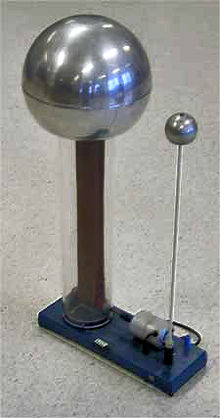Van de Graaff Generator
electrostatic generator that produces high voltages by accumulated tribocharging
A Van de Graaff generator is an electrostatic machine. It uses a moving, nonmetallic belt to accumulate very high voltages on a hollow metal globe. Voltage differences achieved in modern Van de Graaff generators can reach 5 megavolts. Applications for these high voltage generators include driving X-ray tubes, accelerating electrons to sterilize food and process materials, and accelerating protons for nuclear physics experiments. The Van de Graaff generator can be thought of as a constant-current source connected in parallel with a capacitor and a very large electrical resistance. It is named after the American physicist Robert Jemison Van de Graaff, who built the first generators of this style in 1929.
